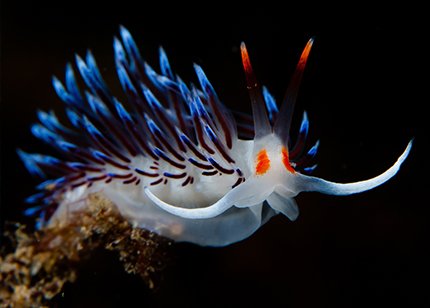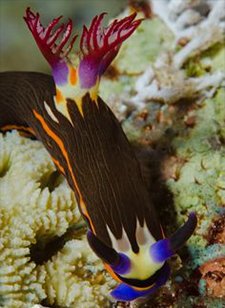5. Red Sea Fairy Basslet, Rotmeer-Fahnenbarsch (Pseuanthias taeniatus)

The small Fairy Basslet can always be seen living close or on the reefs of the Red Sea. As big shoals, they orbit the reef pillars and brighten up all the coral gardens with their large harems and vivid colours. Red Sea Fairy Basslet nourish themselves on the plankton, becoming bigger and growing up to a maximum of 13cm and live in depths of not more than 50mtrs. Fairy Basslet can supply divers with useful information on the current giving you direction and strength simply by watching the shoal.
Status: Harmless
Die kleinen Fahnenbarsche sind nicht aus den Riffen des Roten Meeres wegzudenken. Als große Schwärme umkreisen sie Riffpfeiler und beleben alle Korallengärten mit ihren großen Harems. Rotmeer-Fahnenbarsche ernähren sich von Plankton, werden bis zu 13cm groß und leben in Tiefen von bis zu 50m. Fahnenbarsche sind auch idealeFische für Taucher: Zur Bestimmung der Strömungsrichtung einfach auf diese Fische achten!
Status: Harmlos
6. Soft Coral Seahorse, Weichkorallen-Seepferdchen (Hippocampus sp.)
A rare and mysterious fish of the Hippocampus family the Soft Coral Seahorse sticks to living on soft corals, mainly Gorgorian and in sea grass areas. This species grows to approximately 2cm. Very little is known generally and they are extremely rare. This Seahorse scientifically is still being studied. And although in 1856 it was described for the first time, very little is known about its habits. They live in depths up to 60mtrs and also close to drop off’s, without camouflage and protection.
Status: Harmless
Ein seltenes und geheimnisvolles Seepferdchen. Sie halten sich an Weichkorallen, Gorgonien und im Seegras fest. Diese Art wird nur etwa 2cm groß. Es ist generell nur äußerst wenig über diese Seepferdchen bekannt, wissenschaftlich erforscht sind sie kaum. Und das, obwohl sie schon 1856 erstmals beschrieben wurden. Sie halten sich in bis zu 60m Tiefe auf und leben dort auch an kargen Felswänden, ohne jegliche Tarnung und Schutz.Status: Harmlos
7. Siphon Sponge, Kolonie-Siphonschwamm (Siphonochalina siphonella)
This sponge attracts attention having large oblong tubes that grow together. The Siphon Sponge has a brownish, grey colouring and can grow as tall as 1mtr. One can find the Syphon sponge between 5-45mtrs deep, in lagoons and protected reef areas. Frequently, small shrimps, worms, feather stars or young fish live around the Siphon Sponge.
Status: Harmless
Dieser Schwamm fällt regelrecht auf: Große, längliche Röhren die aneinander wachsen. Er hat eine bräunliche, leicht graue Färbung und kann 1m groß werden. Man kannden Kolonie-Siphonschwamm zwischen 5-45m finden, in Lagunen und geschützten Riffarealen. Häufig leben kleine Garnelen, Würmer, Federsterne oder Jungfische an ihm.
Status: Harmlos
8. Bighorn Nembrotha, Rotmeer-Sternschnecke (Nembrotha megalocera)
The Bighorn Nembrotha lives on sponges, in the gravel or on rocky reef walls. They nourish themselves by feeding on sponges and poison polyps and absorb the poison fordefence they can grow up to 10cm and live between depths of 3-25mtrs. This Nudibranchia is brightly coloured having stripes of black, white and yellow, this attracts attention and acts as a warning. Along its back it has a feather like tentacle and on its head two large snail like horns.
Statuses: Harmless
Die Rotmeer-Sternschnecke lebt auf Schwämmen, im Geröll oder an felsigen Riffwänden. Sie ernähren sich von Schwämmen und Nesseltieren und setzen deren Giftstoffewiederum als Abwehr ein. Sie werden bis zu 10cm groß und leben zwischen 3-25m. Diese Nacktschnecke fällt besonders durch ihre großen Tentakel am Kopf auf. Sie wirken auf einen Beobachter wie große Hörner.
Status: Harmlos
9. Pectinidae sp., Zahnkoralle (Oxypora convoluta )

One can recognize the Pectinidae coral by the strongly bent plates and the teethed edges. One finds Pectinidae coral on protected reef sides and in deep lagoons. With theirbrownish colouring and the essentially lighter edge, they are easier to be distinguished from other corals. Dependent on depth, the growth and the colour of the plates can vary. They live in depths of 15-65mtrs and can reach up to 4.5mtrs in diameter.
Status: Don’t touch!
Die Zahnkoralle kann man an ihren stark gekrümmten Platten und den gezahnten Rändern erkennen. Zahnkorallen findet man an geschützten Riffhängen und in tiefen Lagunen. Mit ihrer bräunlichen Färbung und dem wesentlich helleren Rand, sind sie einfacher von anderen Korallen zu unterscheiden. Aber dennoch, so oft kommt die seltene Koralle wiederum nicht vor. Abhängig von der Tiefe, können auch das Wachstum und die Farbe der Platten variieren. Sie leben in Tiefen von 15-65m und können bis zu 4.5m im Durchmesser erreichen.
Status: Nicht berühren!














